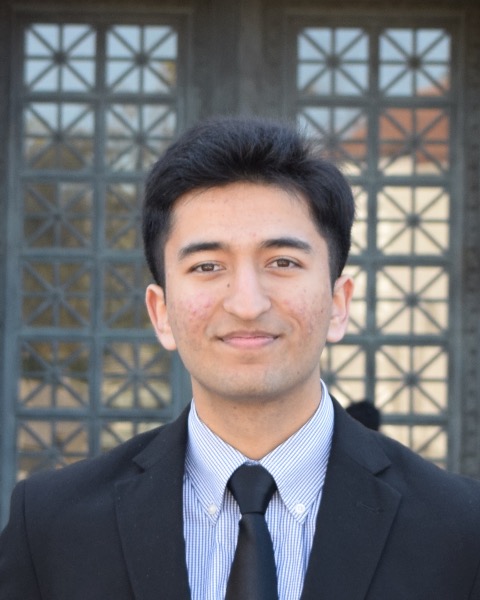Abstract Session
Rapid Fire Research Forum
(AS2) A Single Cell Atlas of Glioblastoma Under Bevacizumab Treatment
Monday, April 24, 2023
1:45pm - 1:50pm PST
Location: Los Angeles Convention Center, 406AB

Poojan Shukla (he/him/his)
Medical Student
University of California San Francisco
San Francisco, California, United States
Presenting Author(s)
Disclosure(s):
Poojan Shukla: No financial relationships to disclose
Introduction: Although hypervascularity is a glioblastoma hallmark, anti-angiogenic therapies such as bevacizumab have not improved survival. Hypothesized resistance mechanisms include co-option of existing vessels, bone marrow derived endothelial progenitor recruitment, and vessel intussusception, but transcriptional changes in tumoral endothelium during progression on bevacizumab remain unknown.
Methods: Single-nucleus RNA sequencing of 71,462 cells from frozen GBM tissue samples of five patients with progression on bevacizumab undergoing surgery within four weeks of last bevacizumab dose and four treatment-naïve GBM patients.
Results: Unsupervised clustering revealed 735 endothelial cells, 552 from treatment-naïve and 183 from bevacizumab-treated patients. CNV analysis showed tumor stem cell transdifferentiation into endothelium was rare in bevacizumab-naïve or treated endothelium (6.7% vs. 4.9%; p=0.5607). Bevacizumab-treated endothelial cells downregulated inflammatory genes CCL3 (Log2-FC= -2.99 , p=1.69e-45), B2M (Log2-FC= -1.59, p=2.5e-46), HLA-A (Log2-FC= -1.87, p=4.63e-43), and IL1B (Log2-FC= -2.0, p=5.29e-30) but upregulated long non-coding RNAs (lncRNA) NEAT1 (Log2-FC=2.58 , p=4.33e-38) and SNHG14 (Log2-FC=2.25, p=1.33e-26) as well as NOTCH4 (Log2-FC=2.2 , p=2.28e-21) and angiopoietin-2 (Log2-FC=1.86, p=2.56e-9). Gene ontology analysis demonstrated enrichment for antigen processing and presentation in treatment-naïve (p=1.28e-6) and healthy reference endothelium (p=4.6e-4) compared to treated endothelium, which showed enrichment for hypoxia response (p=3.49e-2).
Further clustering showed subpopulations of inflammation (GO: antigen processing and presentation, p=6.11e-7), maintenance (GO: cell-cell junction organization, p=0.024), and proliferation (GO: sister chromatid segregation, p=8.91e-14) among treatment-naïve endothelium while treated endothelium featured phenotypes of RNA splicing (p=0.0023) and modest immune activation (GO: leukocyte cell-cell adhesion, p=1.1e-5).
Conclusion : Tumoral endothelium in bevacizumab-treated glioblastoma exhibits decreased inflammation and proliferation, suggesting successful devascularization. Tumor progression despite limited neovascularization may proceed via perivascular invasion, reflected in enrichment of vessel co-option promoting angiopoietin-2, synergized with bevacizumab’s relative immunosuppression, reflected in downregulated inflammatory genes. Future work will investigate the role of lncRNAs such as NEAT1 in endothelial bevacizumab response and the translational implications of bevacizumab-induced immunosuppressive effects on endothelium.
Methods: Single-nucleus RNA sequencing of 71,462 cells from frozen GBM tissue samples of five patients with progression on bevacizumab undergoing surgery within four weeks of last bevacizumab dose and four treatment-naïve GBM patients.
Results: Unsupervised clustering revealed 735 endothelial cells, 552 from treatment-naïve and 183 from bevacizumab-treated patients. CNV analysis showed tumor stem cell transdifferentiation into endothelium was rare in bevacizumab-naïve or treated endothelium (6.7% vs. 4.9%; p=0.5607). Bevacizumab-treated endothelial cells downregulated inflammatory genes CCL3 (Log2-FC= -2.99 , p=1.69e-45), B2M (Log2-FC= -1.59, p=2.5e-46), HLA-A (Log2-FC= -1.87, p=4.63e-43), and IL1B (Log2-FC= -2.0, p=5.29e-30) but upregulated long non-coding RNAs (lncRNA) NEAT1 (Log2-FC=2.58 , p=4.33e-38) and SNHG14 (Log2-FC=2.25, p=1.33e-26) as well as NOTCH4 (Log2-FC=2.2 , p=2.28e-21) and angiopoietin-2 (Log2-FC=1.86, p=2.56e-9). Gene ontology analysis demonstrated enrichment for antigen processing and presentation in treatment-naïve (p=1.28e-6) and healthy reference endothelium (p=4.6e-4) compared to treated endothelium, which showed enrichment for hypoxia response (p=3.49e-2).
Further clustering showed subpopulations of inflammation (GO: antigen processing and presentation, p=6.11e-7), maintenance (GO: cell-cell junction organization, p=0.024), and proliferation (GO: sister chromatid segregation, p=8.91e-14) among treatment-naïve endothelium while treated endothelium featured phenotypes of RNA splicing (p=0.0023) and modest immune activation (GO: leukocyte cell-cell adhesion, p=1.1e-5).
Conclusion : Tumoral endothelium in bevacizumab-treated glioblastoma exhibits decreased inflammation and proliferation, suggesting successful devascularization. Tumor progression despite limited neovascularization may proceed via perivascular invasion, reflected in enrichment of vessel co-option promoting angiopoietin-2, synergized with bevacizumab’s relative immunosuppression, reflected in downregulated inflammatory genes. Future work will investigate the role of lncRNAs such as NEAT1 in endothelial bevacizumab response and the translational implications of bevacizumab-induced immunosuppressive effects on endothelium.
